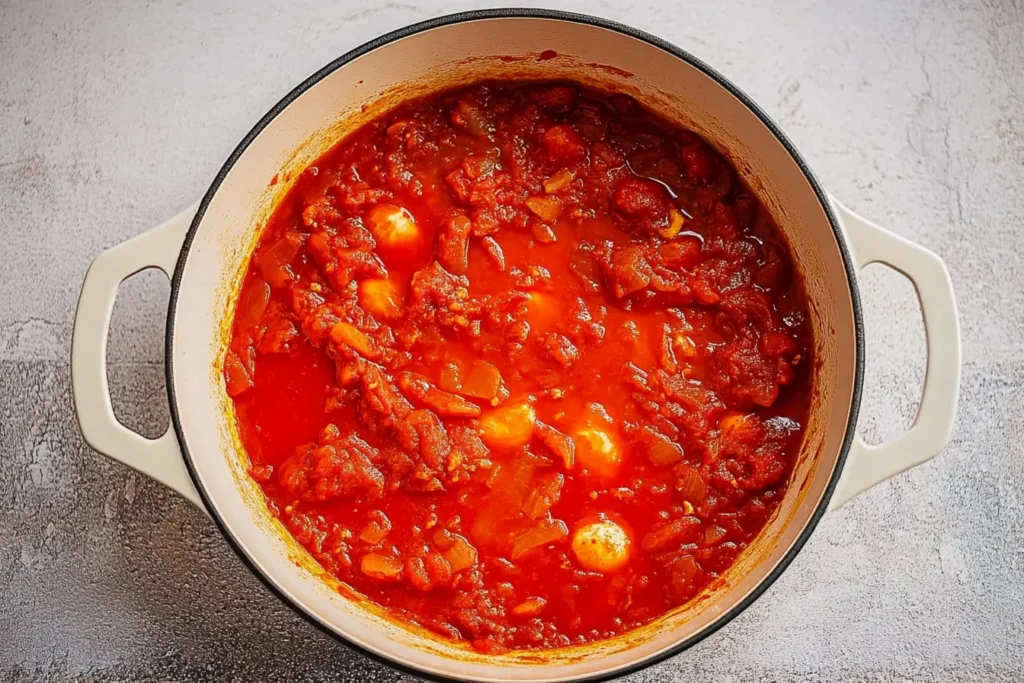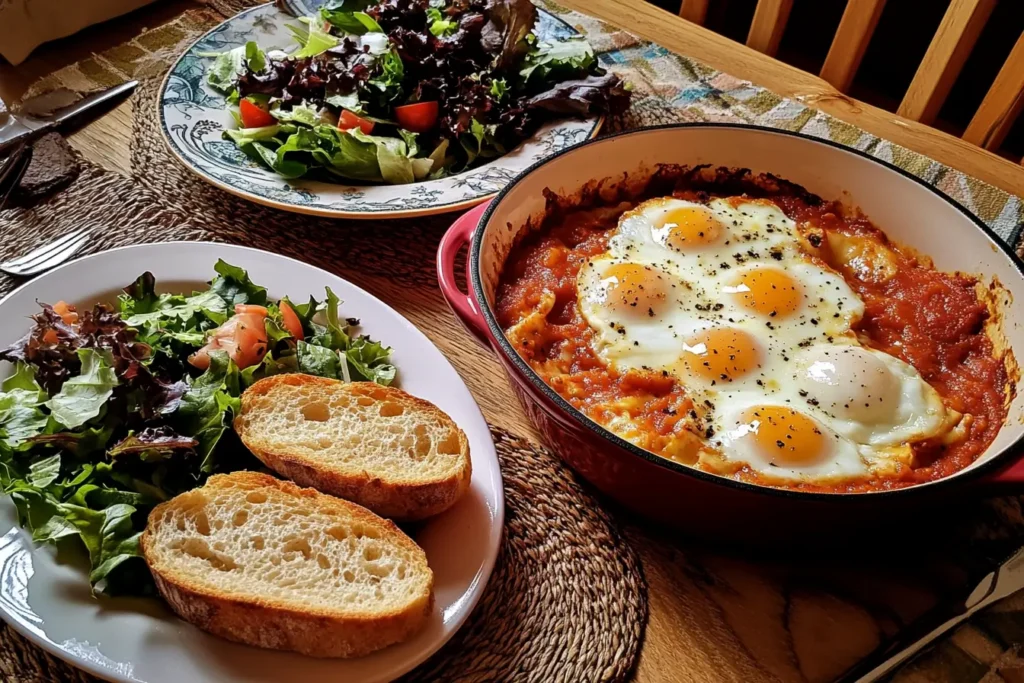Welcome to my kitchen, where family traditions come alive with every dish. Today, I’m excited to share my beloved recipe for Eggs in Purgatory. This dish has been a cherished part of my family for years. I still remember sitting at my grandmother’s table as a child, eagerly watching her create magic in the kitchen.
The aroma of simmering tomatoes and spices would fill the house, and the laughter of family gatherings made every bite extra special. Eggs in Purgatory is more than just a meal it’s a celebration of our heritage and the simple joys of home cooking. In this article, I’ll walk you through each step with warmth and care, just like I learned from my mother and grandmother. I hope you feel as welcomed as family as you dive into this comforting recipe. For more delicious ideas to start your day, check out Breakfast Pizza Delight.
Table of Contents
The History and Origins
A Taste of Tradition
Eggs in Purgatory is a dish steeped in history and tradition. Its roots lie in Italian cuisine, where a rich tomato sauce forms the base of many beloved recipes. This egg dish is a fine example of how simple ingredients can create something extraordinary. Families around the world have adapted it over time, adding their own touches to suit local tastes. I always love how a few basic ingredients can tell a story of tradition and warmth. Discover more about classic Italian flavors with our Italian Baguette Rustic Recipe.
Family Recipes Through the Generations
In my family, recipes are treasured heirlooms passed down through generations. I remember my mother preparing Eggs in Purgatory on lazy weekend mornings. She would call me into the kitchen and let me help stir the bubbling tomato sauce. Each time I prepared this dish on my own, I felt connected to those long-ago family moments. The love and care embedded in each step remind me that food is not just nourishment; it’s a bridge to our past and a source of comfort for our future.
How the Dish Got Its Name: Eggs in Purgatory
The name Eggs in Purgatory has always intrigued me. It is said to come from the dish’s appearance—eggs slowly poaching in a fiery, red sauce that seems to be suspended between heaven and hell. This unique name captures both the spicy kick and the soft, delicate texture of the eggs. Over the years, many have reinterpreted the dish, but its heart remains the same: a blend of rich tomato sauce and perfectly poached eggs that warm you from the inside out.
Ingredients and Tools

Essential Ingredients for Eggs in Purgatory
- Fresh Tomatoes: Use ripe tomatoes for a vibrant sauce.
- Eggs: Farm-fresh eggs work best.
- Garlic and Onions: For a flavorful base.
- Olive Oil: Extra virgin olive oil adds richness.
- Red Pepper Flakes: A little heat goes a long way.
- Fresh Herbs: Basil or parsley for garnish.
- Salt and Pepper: Basic seasonings to enhance flavors.
Each ingredient plays a crucial role. Using fresh produce not only improves taste but also connects you with the seasonal rhythms that have been a part of family traditions for decades. For a fun twist on your meal, explore our guide on What is the Italian Version of a Baguette?.
Kitchen Tools and Equipment
- A large, deep skillet or pan with a lid.
- A sharp knife for chopping vegetables.
- A cutting board for all your prep work.
- A stirring spoon to mix the sauce.
- A spatula for gently moving the eggs around without breaking them.
These simple tools, often already found in your kitchen, remind me of the humble beginnings of many cherished family meals. Each tool carries memories of my mother’s kitchen and the many shared moments of cooking together.
Ingredient Substitutions and Variations
- If you can’t find fresh tomatoes, canned whole tomatoes work well—just crush them by hand.
- Spicy Sausage: Adding a little protein twist.
- Bell Peppers: For extra crunch and sweetness.
- Spinach: Toss in some greens for color and nutrition.
These variations keep the recipe flexible while still preserving the heart of Eggs in Purgatory. Experimenting with substitutions can make the dish your own while honoring its classic roots.
Step-by-Step Recipe Guide

Preparing the Tomato Sauce with a Twist
- Sauté Aromatics: Begin by heating olive oil in your deep skillet over medium heat. Add finely chopped onions and garlic. Stir frequently until they turn soft and fragrant. This step is the soul of your sauce and creates the base of Eggs in Purgatory.
- Add Tomatoes: Next, incorporate your fresh tomatoes (or canned ones). Crush them lightly with your spoon. The natural juices mix with the aromatics to form a robust sauce.
- Season the Sauce: Sprinkle in red pepper flakes, salt, and pepper. Allow the mixture to simmer, stirring occasionally, until the sauce thickens slightly. This simmering process helps blend the flavors together beautifully.
- Personal Touch: Here, feel free to add a pinch of sugar if your tomatoes are too acidic. I often add fresh basil near the end to keep its flavor vibrant and aromatic.
Perfecting the Eggs: Cooking Techniques for a Custardy Center
- Create Space in the Sauce: Make small wells in the sauce with the back of your spoon. This will help you gently place the eggs without breaking them.
- Add the Eggs: Crack each egg carefully into a bowl, then slide it into the well you created. Avoid crowding the pan to ensure even cooking.
- Cover and Poach: Cover the skillet with a lid. Let the eggs poach gently over low heat. Keep an eye on them until the whites are set but the yolks remain runny. This method preserves the custard-like texture that makes Eggs in Purgatory so irresistible.
- Check Consistency: If you prefer firmer yolks, let them cook a few minutes longer. Every family has their own preference, so adjust the cooking time as needed.
Combining It All: Bringing the Dish Together
- Final Simmer: Once the eggs are cooked to your liking, give the sauce one last stir. This step helps to meld the flavors together even more.
- Garnish and Serve: Sprinkle freshly chopped parsley or basil over the dish. Serve hot with crusty bread or a side of your favorite greens.
- Presentation: A well-plated dish always feels special. I like to add a drizzle of olive oil on top and a sprinkle of extra red pepper flakes for that final touch of warmth.
- Family Moment: Every time I serve Eggs in Purgatory, I think of those cozy mornings with my family. The aroma, the gentle bubbling of the sauce, and the tender eggs remind me of the love that goes into every meal. For another delicious Italian-inspired dish, try our Chicken Parmesan Garlic Pasta.
Tips, Variations, and Serving Suggestions

Family-Inspired Variations for Eggs in Purgatory
- Cheesy Twist: For a creamy version, add a handful of shredded mozzarella or Parmesan during the final minutes of cooking.
- Spicy Upgrade: If you like a bit of extra heat, increase the amount of red pepper flakes or even stir in some chopped jalapeños.
- Vegetable Boost: Add diced bell peppers or zucchini to the sauce for added texture and nutrition.
Each variation is a nod to family creativity and the joy of making the dish your own.
Serving Suggestions for a Cozy Meal
- Bread on the Side: Serve your Eggs in Purgatory with slices of warm, crusty bread to scoop up the savory tomato sauce.
- Fresh Salad: A simple mixed green salad with a light vinaigrette makes a perfect companion to balance the richness of the dish.
- Brunch Special: Enjoy this recipe as a hearty brunch option. Pair it with a fresh fruit salad or a hot cup of coffee for a complete meal.
Storing Leftovers and Reheating Tips
- Refrigeration: Store any leftovers in an airtight container in the fridge for up to two days.
- Reheating: Reheat gently on the stovetop over low heat to maintain the texture of the eggs. Alternatively, microwave in short bursts, stirring in between.
- Repurposing: Leftover tomato sauce can be used as a base for pasta dishes or even a pizza topping, ensuring that every bit of this delicious recipe is enjoyed.
For health and safety tips on food storage, check out Healthline.
FAQ Section
Why do they call it Eggs in Purgatory?
The name Eggs in Purgatory likely stems from the dish’s dramatic appearance—eggs slowly poaching in a fiery tomato sauce, as if suspended in a state of transformation. This poetic name reflects the dish’s origins in Italian cuisine, where imaginative names often add a layer of charm and mystery. The term “purgatory” suggests that the eggs are caught in a delicious limbo between being raw and fully cooked, making every bite a heavenly experience. Over time, this evocative name has grown to represent both tradition and culinary creativity.
What’s in Eggs in Purgatory?
Eggs in Purgatory is a simple yet flavorful dish that features eggs poached in a rich tomato sauce. The core ingredients include ripe tomatoes, garlic, onions, and red pepper flakes, all simmered in olive oil to create a vibrant base. Fresh herbs like basil or parsley are added at the end for brightness. The eggs, often farm-fresh, are gently poached until the whites set while the yolks remain soft and runny, creating a perfect balance of textures and flavors that is both comforting and satisfying.
What is the difference between Shakshuka and Eggs in Purgatory?
While Eggs in Purgatory and Shakshuka share many similarities, they each have distinct regional flavors and histories. Shakshuka, popular in Middle Eastern and North African cuisines, typically includes a blend of spices like cumin and paprika along with a robust tomato base. In contrast, Eggs in Purgatory tends to emphasize Italian flavors with a simpler seasoning profile focused on garlic, olive oil, and red pepper flakes. The differences in spice combinations and presentation give each dish a unique identity, yet both celebrate the beauty of poached eggs in a savory tomato sauce.
What are the Eggs in Limbo?
The term “Eggs in Limbo” is a playful variation sometimes used to describe a similar egg dish where the eggs remain in a semi-cooked, suspended state within a flavorful sauce. While not as widely recognized as Eggs in Purgatory, it hints at the same concept—eggs caught between states of doneness, allowing the yolks to remain deliciously soft. This creative naming reflects the regional interpretations and culinary experiments that make egg dishes so versatile and beloved across different cultures. For more creative recipe ideas and culinary inspiration, you might also enjoy visiting the Food Network.
Conclusion
In closing, Eggs in Purgatory is more than just a recipe—it’s a heartfelt tradition that brings family and friends together. Every step, from preparing the vibrant tomato sauce to poaching the perfect eggs, carries memories of home and the warmth of generations past. I invite you to try this dish and make it your own by adding your special twist. Embrace the simplicity and richness of this meal and share it with those you love. Happy cooking, and may your kitchen always be filled with the aroma of cherished family recipes. For more comforting ideas, check out our Cream Cheese Bagel Recipe.
Print
Eggs in Purgatory: Tasty 5-Step Mouth-Watering Recipe
- Total Time: 15 minutes
- Yield: 4 servings
Description
Enjoy a heartwarming family classic with Eggs in Purgatory. This dish features perfectly poached eggs simmered in a spicy, rich tomato sauce that will brighten your day.
Ingredients
• 4 large farm-fresh eggs
• 5 medium ripe tomatoes (or one 14.5 oz can of whole tomatoes, crushed)
• 1 small onion, finely chopped
• 3 cloves garlic, minced
• 2 tablespoons extra virgin olive oil
• 1/2 teaspoon red pepper flakes (adjust to taste)
• Salt and pepper to taste
• Fresh basil leaves, chopped (optional)
• A pinch of sugar (if tomatoes are too acidic)
Instructions
- Heat the olive oil in a deep skillet over medium heat.
- Add the chopped onion and garlic; sauté until soft and fragrant.
- Stir in the tomatoes and crush lightly. Add red pepper flakes, salt, and pepper. Let the sauce simmer for about 10 minutes until it thickens. (For extra balance, add a pinch of sugar if needed.)
- Create small wells in the sauce and carefully crack the eggs into them.
- Cover the skillet and let the eggs poach for 5–7 minutes until the whites are set but the yolks remain deliciously runny.
- Garnish with fresh basil and serve immediately with crusty bread.
Notes
• For a cheesy twist, sprinkle shredded mozzarella over the eggs during the last 2 minutes of poaching.
• Store leftovers in an airtight container in the fridge for up to 2 days. Reheat gently on the stovetop to preserve the texture.
• This versatile recipe works wonderfully as a hearty breakfast or a light dinner.
- Prep Time: 15 minutes
- Category: Breakfast/Brunch
- Cuisine: Italian
Nutrition
- Serving Size: 1 plate
- Calories: 220 kcal
- Sugar: 5g
- Sodium: 350mg
- Fat: 12g
- Saturated Fat: 2g
- Unsaturated Fat: 10g
- Carbohydrates: 18g
- Fiber: 4g
- Protein: 12g
- Cholesterol: 210mg
Keywords: Eggs in Purgatory, family recipe, tomato sauce eggs, hearty breakfast, Italian comfort food

